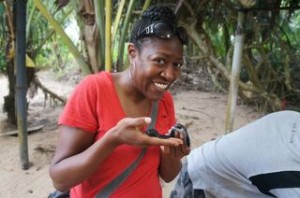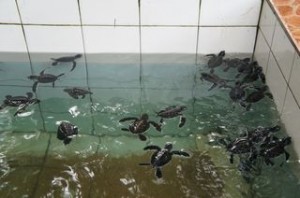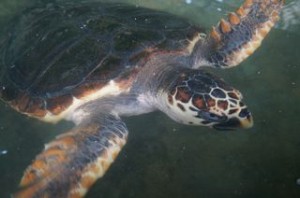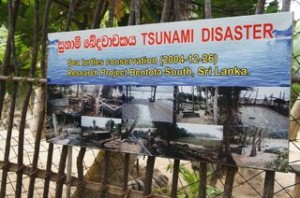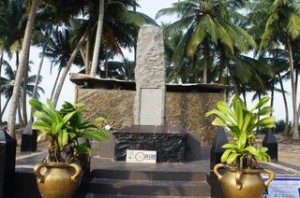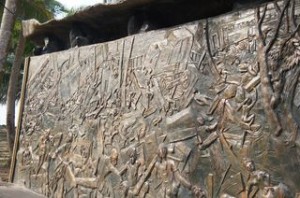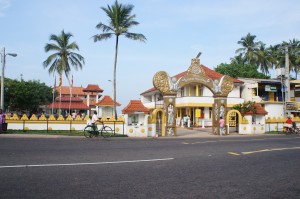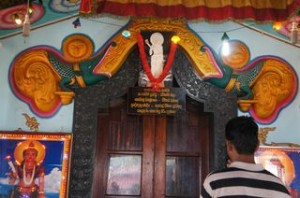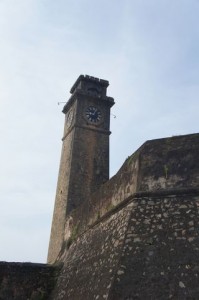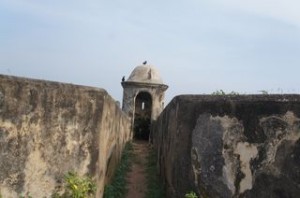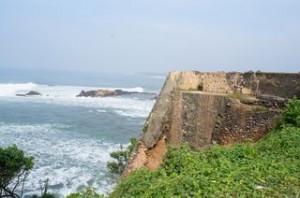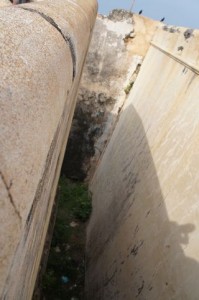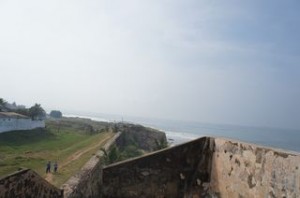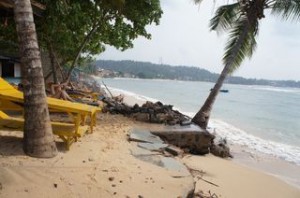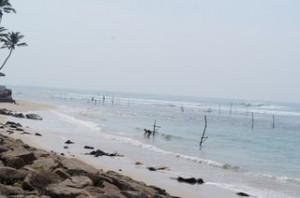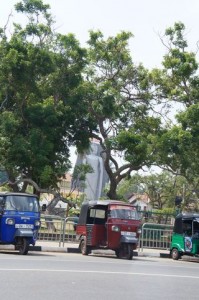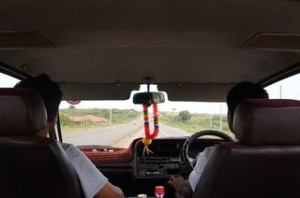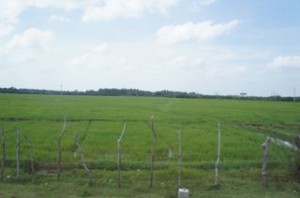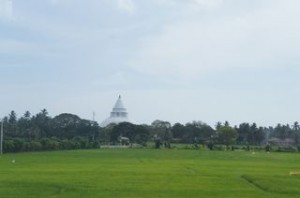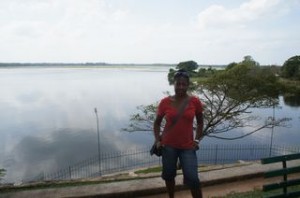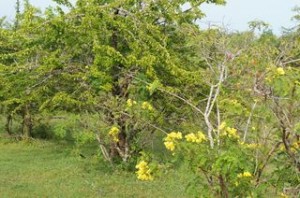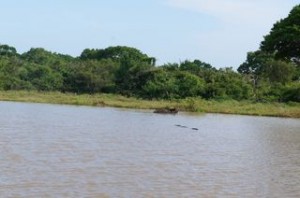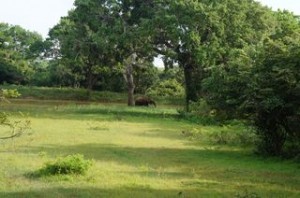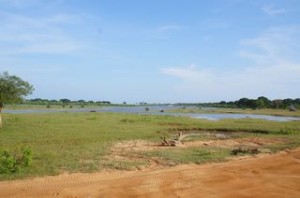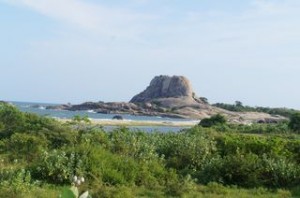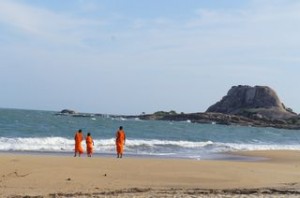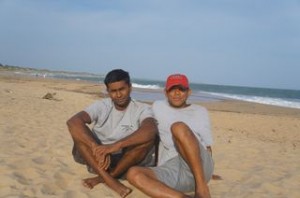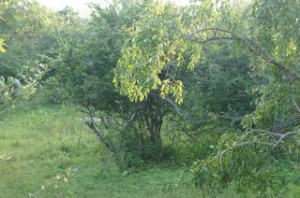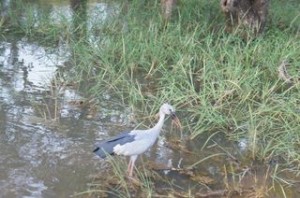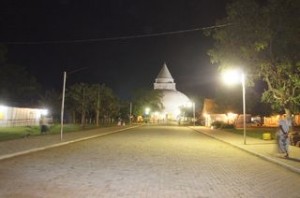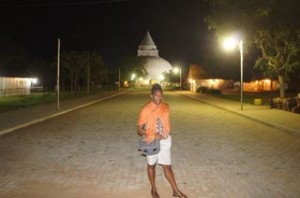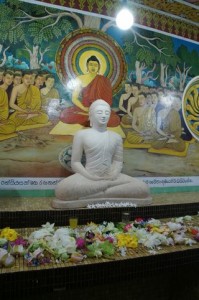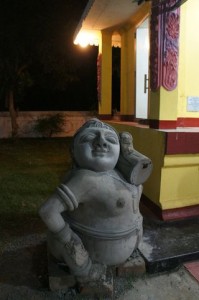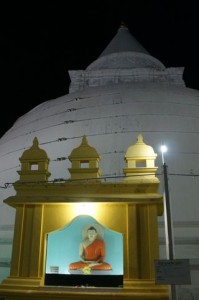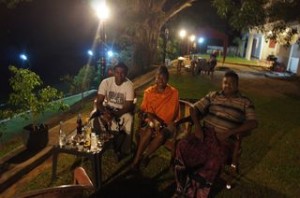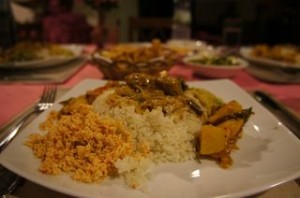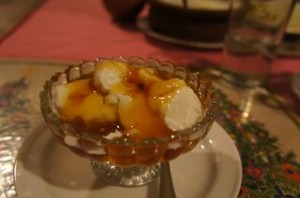Baby sea turtles are slippery, squirmy and one of the cutest things I’ve ever had the pleasure of holding. Our guide at the Bentota Turtle Research Project simply hands them to me as he talks and I fall in love, instantly, stroking the smooth back of a green sea turtle hatchling and the bumpy one of a loggerhead. We’ve already seen the fenced-in nesting area at the small conservation facility where little mounds of sand containing sea turtle eggs are marked by type of turtle. When the babies hatch in about 2 months time, the staff and volunteers will help usher the hatchlings safely into the ocean. On their own, the endangered creatures, practically blind at birth could succumb to predators, or worse, poachers could steal the eggs before they even hatch for a culinary delicacy.
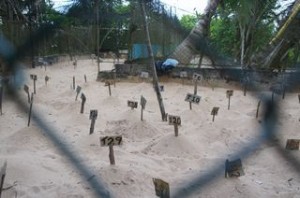 I’m with Sid and Pradeep and this is the first stop on our four-day road trip along the southern coast of Sri Lanka, through its mountains and back west for my departure back to the US. Bentota is another beach town a few miles south of Beruwela and Moragalla and the Turtle Research Project is one of its most-mentioned attractions. When we arrive in the early morning, we are its only guests except for a cat that seems to like to curl itself around visitors feet. We visit with the residents of the project–sea turtles that have been hatched there from eggs purchased from fisherman who’ve found them, turtles that have been found, rescued and rehabilitated like one missing its two flipper-like legs. We are introduced to days-old babies and adolescent loggerhead, hawksbill and green turtles, all native to Sri Lanka’s southern shores and threatened by fishing, sale of their skin and shells, pollution and beach development. And one of the residents, extremely rare, closes out our tour–an albino green turtle, aptly named Michael Jackson. He’s beautiful. We also survey the damage that the hatchery suffered during the tsunami, seeing cracked cement tanks and bent trees. You can tell that recovery is slow here and I hope my small contribution in the form of about a $5 entrance fee and $8 sea turtle magnet help some. I leave recalling my recent trip to Barbados where I swam a fingertips-length away from sea turtles there, sensing their gentleness.
I’m with Sid and Pradeep and this is the first stop on our four-day road trip along the southern coast of Sri Lanka, through its mountains and back west for my departure back to the US. Bentota is another beach town a few miles south of Beruwela and Moragalla and the Turtle Research Project is one of its most-mentioned attractions. When we arrive in the early morning, we are its only guests except for a cat that seems to like to curl itself around visitors feet. We visit with the residents of the project–sea turtles that have been hatched there from eggs purchased from fisherman who’ve found them, turtles that have been found, rescued and rehabilitated like one missing its two flipper-like legs. We are introduced to days-old babies and adolescent loggerhead, hawksbill and green turtles, all native to Sri Lanka’s southern shores and threatened by fishing, sale of their skin and shells, pollution and beach development. And one of the residents, extremely rare, closes out our tour–an albino green turtle, aptly named Michael Jackson. He’s beautiful. We also survey the damage that the hatchery suffered during the tsunami, seeing cracked cement tanks and bent trees. You can tell that recovery is slow here and I hope my small contribution in the form of about a $5 entrance fee and $8 sea turtle magnet help some. I leave recalling my recent trip to Barbados where I swam a fingertips-length away from sea turtles there, sensing their gentleness.
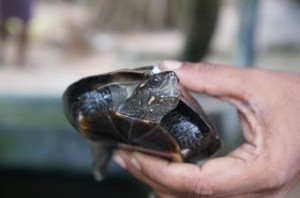
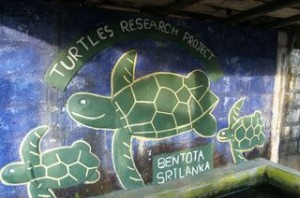
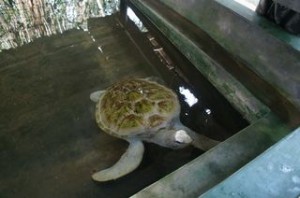 The rest of our journey takes us farther south along route A2, which is a continuation of the same two-lane thoroughfare from Colombo to Beruwela with cars, bikes, tuk-tuks, buses and trucks zig-zagging in and out of on coming traffic. As we drive, Pradeep takes on his role as expert driver and guide, telling me that the beach between Bentota and Kosgoda is protected for sea turtles. Kosgoda is another place with several conservation projects and hatcheries. Just past Kosgoda we pull off the road long side a small obelisk and bronze relief. Pradeep says this is a memorial to 2004 tsunami victims. We are in Peraliya where some 1,500 people died on trains at the train station in town and I learn Pradeep’s own tsunami tale. He’d gone for a swim that morning when saw the massive waves. He took off running for in land, helping people up into coconut trees along the way. In total, over 30,000 people in Sri Lanka would die as a result of the natural disaster. The small memorial to them faces the roadway, seeming to turning its back on the ocean that betrayed the small town of Peraliya. The bronze relief behind the stone obelisk depicts the chaotic scene that day with toppled train cars, despairing and escaping victims, along with the dead. It is graphic in its retelling and compelling. Crumpled concrete structures dot the landscape around us, continuing the story, and just across the street is an amazing and glorious gift from the Japanese, another memorial in the shape of a massive standing Buddha, the Tsunami Honganji Vihara. The statue is said to be a replica of a Buddha that once stood in Afghanistan and was destroyed by the Taliban. The Buddha stands serene with one hand raised as if it is quieting the ocean it faces.
The rest of our journey takes us farther south along route A2, which is a continuation of the same two-lane thoroughfare from Colombo to Beruwela with cars, bikes, tuk-tuks, buses and trucks zig-zagging in and out of on coming traffic. As we drive, Pradeep takes on his role as expert driver and guide, telling me that the beach between Bentota and Kosgoda is protected for sea turtles. Kosgoda is another place with several conservation projects and hatcheries. Just past Kosgoda we pull off the road long side a small obelisk and bronze relief. Pradeep says this is a memorial to 2004 tsunami victims. We are in Peraliya where some 1,500 people died on trains at the train station in town and I learn Pradeep’s own tsunami tale. He’d gone for a swim that morning when saw the massive waves. He took off running for in land, helping people up into coconut trees along the way. In total, over 30,000 people in Sri Lanka would die as a result of the natural disaster. The small memorial to them faces the roadway, seeming to turning its back on the ocean that betrayed the small town of Peraliya. The bronze relief behind the stone obelisk depicts the chaotic scene that day with toppled train cars, despairing and escaping victims, along with the dead. It is graphic in its retelling and compelling. Crumpled concrete structures dot the landscape around us, continuing the story, and just across the street is an amazing and glorious gift from the Japanese, another memorial in the shape of a massive standing Buddha, the Tsunami Honganji Vihara. The statue is said to be a replica of a Buddha that once stood in Afghanistan and was destroyed by the Taliban. The Buddha stands serene with one hand raised as if it is quieting the ocean it faces.
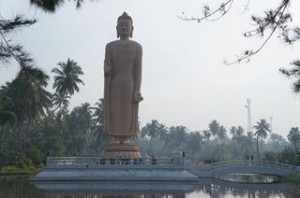 We move on to see a spot that miraculously withstood the angry Indian Ocean that fateful day in 2004. Again, we’ve pulled off A2 where there is a golden gate marking the entrance of Seenigama Temple. Locals have come to offer their blessings to the god Vishnu at the small roadside temple where colorful images of the god are surrounded by twinkling lights and Sid and I enter and kneel briefly, too. But it is the temple sitting on a rocky outcrop in the middle of the ocean that is the miracle. It somehow remained intact despite its precarious location. Maybe it has something to do with the deity for which it is dedicated, “Devoldevi,” one that accepts wishes of punishment from worshipers seeking revenge on people who’ve done them wrong. It is also one that local fishermen respect greatly, believing that it keeps them out of harms way.
We move on to see a spot that miraculously withstood the angry Indian Ocean that fateful day in 2004. Again, we’ve pulled off A2 where there is a golden gate marking the entrance of Seenigama Temple. Locals have come to offer their blessings to the god Vishnu at the small roadside temple where colorful images of the god are surrounded by twinkling lights and Sid and I enter and kneel briefly, too. But it is the temple sitting on a rocky outcrop in the middle of the ocean that is the miracle. It somehow remained intact despite its precarious location. Maybe it has something to do with the deity for which it is dedicated, “Devoldevi,” one that accepts wishes of punishment from worshipers seeking revenge on people who’ve done them wrong. It is also one that local fishermen respect greatly, believing that it keeps them out of harms way.
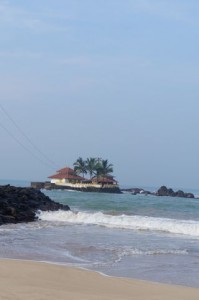 Back in our white mini van, we pass though one of Sri Lanka’s well-known beach towns–Hikkaduwa, a surfers destination spot where Sid once played with his band at the Why Not Hotel. And then, we are our way to Galle, which looks pretty modern for an old colonial town founded by the Portuguese in the 1500s. It’s bus station is massive and brand new; the old one destroyed by the tsunami. It’s streets are crowded with traffic and there is a different, more urban energy to the place. Our specific destination here is the old Galle Fort, initially a small bastion created by the Portuguese and then significantly expanded by the Dutch who settled here in the 1600s to protect the valuable goods coming in and out of its port. We first walk through a small gate onto a flat grassy expanse surrounded by stone walls. A group of men are enjoying the open space, stretching on mats. When we look beyond the walls, we have a perfect view of the modern Galle from the old Galle, seeing the cricket stadium and busy bus station below. Gun towers along the wall are a reminder of the original purpose of the place. On the other side of a huge clock tower is a stunning view of the ocean and you can see just how impressive this fort must look if you are a boat approaching. It’s craggy walls seem to spring up from the rocks below. Sid and Pradeep are eager to point out the prison in the fort, a deep and narrow walled space, impossible for 17th century baddies to escape, unless you were Spiderman. The fort walls stretch for miles and when we leave, I see that it really is a small city unto itself and I can see why it is a UNESCO World Heritage site. Hotels and shops line the narrow streets within the fort walls for folks that want to sleep in or shop for a piece of history.
Back in our white mini van, we pass though one of Sri Lanka’s well-known beach towns–Hikkaduwa, a surfers destination spot where Sid once played with his band at the Why Not Hotel. And then, we are our way to Galle, which looks pretty modern for an old colonial town founded by the Portuguese in the 1500s. It’s bus station is massive and brand new; the old one destroyed by the tsunami. It’s streets are crowded with traffic and there is a different, more urban energy to the place. Our specific destination here is the old Galle Fort, initially a small bastion created by the Portuguese and then significantly expanded by the Dutch who settled here in the 1600s to protect the valuable goods coming in and out of its port. We first walk through a small gate onto a flat grassy expanse surrounded by stone walls. A group of men are enjoying the open space, stretching on mats. When we look beyond the walls, we have a perfect view of the modern Galle from the old Galle, seeing the cricket stadium and busy bus station below. Gun towers along the wall are a reminder of the original purpose of the place. On the other side of a huge clock tower is a stunning view of the ocean and you can see just how impressive this fort must look if you are a boat approaching. It’s craggy walls seem to spring up from the rocks below. Sid and Pradeep are eager to point out the prison in the fort, a deep and narrow walled space, impossible for 17th century baddies to escape, unless you were Spiderman. The fort walls stretch for miles and when we leave, I see that it really is a small city unto itself and I can see why it is a UNESCO World Heritage site. Hotels and shops line the narrow streets within the fort walls for folks that want to sleep in or shop for a piece of history.
We are now headed to our ultimate destination, Yala National Park, where we’ll go on a safari. We are to meet our guide at 2 pm in Tissamaharama, a town just outside the park. In the meantime, we pass through more beach towns, Unawatuna, a hippie beach paradise where beach houses and cafes sit right at the waters edge and backpackers roam its sandy streets, and Weligama, where we see Sri Lankan fishing boats at rest on the beach and a small roadside fish market. Just past Weligama, we make another quick stop. This time we’ve stopped to see if we can see the stilt fishermen usually perched atop sticks with rods made of coconut trees stationed just off shore in the area, but the ocean is a bit rough today. Sid and I scramble over some rocks at the edge of the beach to see two lone fishermen in the distance, too far for a good photo. So, we hop back in the van and continue on through Matara, the hometown of Sri Lanka’s current president and site of another huge Buddha, just outside the city, then Dikwella, which means long beach in Sinhalese. At this point the drive turns more rural. The houses are set farther apart and Sid and Pradeep start to giggle at the names of the small towns we pass, Godauda, which sounds like “Gooda-Ooda” and Tangalle, which I don’t get until they explain that Tangalle also means “Titty” in Sinhalese. Then we are on open road passing rice and salt farms, when the road starts to looks brand new and Pradeep says we are in Hambantota where they are building a new port. Shortly thereafter, we make a stop at a roadside motel and diner of sorts to pick up lunch. There are a surprising number of diners in the place which seems to spring out of no where. We also need to take a bathroom break and I see toilets that I recognize from my travels in China, a hole in the floor surrounded by porcelain footholds. I have to remember how to artfully squat and I’m thankful that I’ve brought my Purel. Sid is excited about the spread at the place with fried lake fish and a vegetable dish that doesn’t translate into english, but he says is good and good for your eyes. Then a mile or so down the road, Pradeep says we have to stop for curd and honey, specifically buffalo curd and honey. He explains that there are many varieties of honey in Sri Lanka and they are all delicious. The honey is poured over the curd, and greek yogurt with honey comes to mind. He says that’s exactly what it’s like and now I’m looking forward to trying it. The woman at the stand outside her home wraps the curd neatly in newspaper with twine and gives us a bottle of honey for the road.
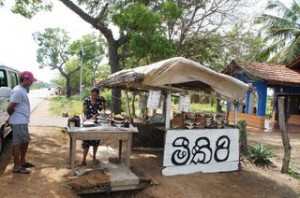 Finally, we are in Tissamaharama, Tissa for short. The town is named for an ancient ruler who Sid and Pradeep say built the lovely man-made lake and stunning spherical temple (dagoba)in the center of town. We pick up our guide Susantha on the way to our hotel, the appropriately named Lake Wind Hotel, which backs Lake Tissamaharama. Floor to ceiling windows showcase the hotels prime placement and it is a perfect setting except that the hotel is under a small renovation. We break for a quick lunch and I do enjoy the untranslatable green veggie that looks like parsley. Then we are in Susantha’s giant jeep on our way to Yala. Pradeep says he’s gotten us the best guide and that Susantha has been doing these tours since a very young age. Susantha so far is a man of few words, dressed in polo shirt and sarong, focused on getting us to the park. When we arrive, we pay the entrance fee, $14 for me, $1.50 for Sid and Pradeep as Sri Lankan citizens, and walk around the small museum telling us of the park’s early history as a British game park in the 1800s when hundreds of elephants were slaughtered. In 1938, Yala became a national park and is now home to hundreds of species of birds, over 300 elephants and the largest concentration of leopards in the world, numbering 35 or so, which sadly, doesn’t seem like like a lot.
Finally, we are in Tissamaharama, Tissa for short. The town is named for an ancient ruler who Sid and Pradeep say built the lovely man-made lake and stunning spherical temple (dagoba)in the center of town. We pick up our guide Susantha on the way to our hotel, the appropriately named Lake Wind Hotel, which backs Lake Tissamaharama. Floor to ceiling windows showcase the hotels prime placement and it is a perfect setting except that the hotel is under a small renovation. We break for a quick lunch and I do enjoy the untranslatable green veggie that looks like parsley. Then we are in Susantha’s giant jeep on our way to Yala. Pradeep says he’s gotten us the best guide and that Susantha has been doing these tours since a very young age. Susantha so far is a man of few words, dressed in polo shirt and sarong, focused on getting us to the park. When we arrive, we pay the entrance fee, $14 for me, $1.50 for Sid and Pradeep as Sri Lankan citizens, and walk around the small museum telling us of the park’s early history as a British game park in the 1800s when hundreds of elephants were slaughtered. In 1938, Yala became a national park and is now home to hundreds of species of birds, over 300 elephants and the largest concentration of leopards in the world, numbering 35 or so, which sadly, doesn’t seem like like a lot.
So, Yala is very bumpy. The roads are a dusty, pitted red, orange and between dodging massive potholes and mini lakes in the road we set about the business of spotting animals. Here, Susantha is in his element. He’s some how able to expertly navigate the terrible road conditions and stop to point out some hard-to-see critter. The first is a small green bird, barely noticeable to the naked eye against its leafy green backdrop. I believe this was an orange-breasted green pigeon. We have no trouble spotting the peacocks and peahens than seem to rule here. The other animals seem to be hiding on this day, possibly spooked by the high volume of jeeps full of leering tourists. Our hope was that arriving around dusk would be the best time for wildlife spotting as the animals come out when the sun sets to visit the park’s watering holes. The animals had other thoughts. We were lucky enough to spot a young elephant bathing in the distance and we hoped for an Animal Planet “Untamed and Uncut” moment when we saw a bathing water buffalo apparently being stalked by a crocodile. But the croc seemed to be taking its sweet time making its move. The talk of the park, though, was the leopard sighting. As we passed other guides, they shared the location of the big cat and we bounced our way in its direction only to find a traffic jam of jeeps trying to sneak a peek at the the same cat. This is where Susantha swings into action, finding some untraveled route and putting us right in front of the clearing where the leopard was lazing. He cut off another jeep in line so that we could get an even closer look and a photo. I was able to get one fairly good photo of the reclining cat, mainly of its spotted belly. Even with all the hullaballoo around, it couldn’t be bothered to raise a paw. The sunset at Yala was beautiful and we manage to glimpse more animals as we leave with a parting glance at an elephant near the park’s entrance.
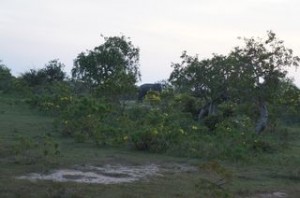 We return to the hotel to shower off the red dust of Yala and rest for a bit before heading back out to visit the Tissamaharama Dagoba. The glowing 160-ft half sphere was said to once have housed one of Buddha’s teeth and his forehead bone, now there are a series of small Buddhas to receive blessings. We step out of our shoes and make the full circle around the dagoba as other have come to do, reciting their prayers. It is extremely peaceful here. Back at the hotel, it is peaceful as well. We are sitting by the lake having drinks with Susantha and trying to secure a hotel in Kandy for the next night and in Sigiriya the following night. We are kind of flying by the seat of our pants and decided staying in Kandy would be better than staying overnight in Nuwra Eliya as planned previously. But all the hotels in Kandy appear to be booked. Susantha and Pradeep are working their connections, mobile phones pressed to their ears. It turns out that Susantha maybe the Emil of Tissa. He knows everyone including Sid’s brother, Nihal and Uncle Emil himself. It seems that its a small world in Sri Lanka, too. And it’s Susantha who comes through with a friend’s guest house in Kandy. Over the course of my trip, I’ve learned that it’s good to be connected in Sri Lanka and traveling with Sri Lankans if you aren’t one. You get the Sri Lankan price like $52 for a room at the Lake Wind Hotel, which may cost a tourist $100 or more.
We return to the hotel to shower off the red dust of Yala and rest for a bit before heading back out to visit the Tissamaharama Dagoba. The glowing 160-ft half sphere was said to once have housed one of Buddha’s teeth and his forehead bone, now there are a series of small Buddhas to receive blessings. We step out of our shoes and make the full circle around the dagoba as other have come to do, reciting their prayers. It is extremely peaceful here. Back at the hotel, it is peaceful as well. We are sitting by the lake having drinks with Susantha and trying to secure a hotel in Kandy for the next night and in Sigiriya the following night. We are kind of flying by the seat of our pants and decided staying in Kandy would be better than staying overnight in Nuwra Eliya as planned previously. But all the hotels in Kandy appear to be booked. Susantha and Pradeep are working their connections, mobile phones pressed to their ears. It turns out that Susantha maybe the Emil of Tissa. He knows everyone including Sid’s brother, Nihal and Uncle Emil himself. It seems that its a small world in Sri Lanka, too. And it’s Susantha who comes through with a friend’s guest house in Kandy. Over the course of my trip, I’ve learned that it’s good to be connected in Sri Lanka and traveling with Sri Lankans if you aren’t one. You get the Sri Lankan price like $52 for a room at the Lake Wind Hotel, which may cost a tourist $100 or more.
After a good meal of chicken curry, sambal and a pumpkin curry dish along with our dessert of curd and honey, which tasted a lot like a thick yogurt, I feel dizzy with all the day’s amazing sights and activities, probably my the longest day in Sri Lanka so far. I say my goodnights and leave Sid and Pradeep to watch a cricket match on the hotel lobby TV.
